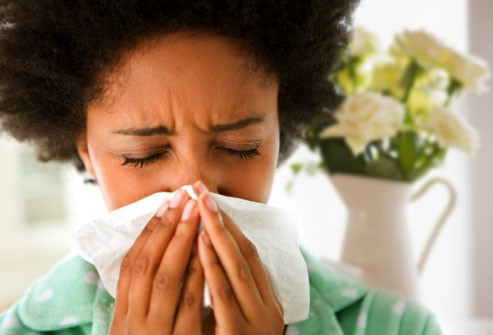Allergies are your body’s defence mechanism against a material it perceives as a dangerous “invader.” For instance, coming into contact with a generally harmless material, such as pollen, may elicit a response from your immune system (your body’s defence system). Allergens are substances that induce these reactions. Here are some frequently asked questions (Soalan) by many about allergies:
What types of allergies are there and how are they treated?
Allergies to a range of things are possible, including pollen, animal dander, mould, and dust mites.
- Pollen: Allergic rhinitis, sometimes known as hay fever, is an allergic reaction to pollen. It irritates and inflames the lining of your nose and the protective tissue around your eyes (conjunctiva).
- Dust mites: Dust mites are microscopic organisms that dwell in dust and the fibres of household items such as pillows, mattresses, carpeting, and upholstery. Dust mites flourish in warm, moist climates.
- Moulds: Moulds are microscopic fungi (similar to Penicillium) that produce spores that float in the air like pollen. Allergies are frequently triggered by mould. Mould can be found both indoors and outdoors in moist areas such as the basement, kitchen, or bathroom, as well as in grass, leaf piles, hay, mulch, or under mushrooms. Mould spores are most abundant in hot, humid weather.
- Animal dander: Allergic reactions to animal dander can be triggered by proteins released by sweat glands in an animal’s skin that are shed, as well as proteins in an animal’s saliva.
- Latex: Some individuals acquire a latex allergy as a result of repeated exposure to latex. Rubber gloves, such as those used in surgery or household cleaning, are a significant source of this reaction.
- Certain foods: Food allergies develop when your body produces an antibody towards a particular food. Within minutes after ingesting the item, an allergic reaction starts, and symptoms might be severe. The most frequent food allergies in adults are to shellfish, peanuts, and tree nuts. They include milk, egg, soy, wheat, shellfish, peanuts, and tree nuts in youngsters.
- Venomous insects (stings): If you are stung by a bee, a typical reaction is pain, swelling, and redness surrounding the sting site. Swelling that goes beyond the sting site is considered a significant, local reaction. If you are stung on the ankle, for instance, you may notice swelling in your leg.
Is it true that everyone develops allergies?
No. The majority of allergies are hereditary, which means they are handed down from parents to children. Individuals inherit an inherited proclivity to be allergic, yet not to any particular allergen. If your child has an allergy, you or your partner are quite likely to have allergies as well.
What are the allergy symptoms?
Allergy symptoms are divided into three categories: mild, moderate, and severe.
- Mild reactions include rashes or hives, itching, watery/red eyes, hay fever, and a runny noseMild reactions are not infectious and do not spread to other organs.
- Moderate reactions involve the spread of symptoms to other regions of the body. Itching, hives, swelling, and/or difficulty breathing are possible symptoms.
- Anaphylaxis, or a severe allergic reaction, is a rare, life-threatening emergency in which your body’s response to an allergen is abrupt and affects the entire body. Anaphylaxis may manifest itself as extreme itchiness in the eyes or face. Within minutes, more significant symptoms such as throat swelling (which may cause difficulty swallowing and breathing), abdominal pain, cramps, vomiting, diarrhoea, hives, and swelling begin to manifest (angioedema). Additionally, you may experience mental confusion or dizziness, as anaphylaxis can result in a reduction in blood pressure.
What is the source of allergies?
Anything that comes into contact with your body that it perceives as a “harmful invader” can trigger an allergy. Pollen, animal dander, mould, dust, foods, insect venom, and latex are all examples of normally harmless items that can trigger allergies.
How are allergies identified?
If you believe you have allergies, do not wait for your symptoms to subside. Make an appointment with an allergy/immunology specialist if your symptoms persist for more than a week or two and frequently recur. Allergy skin testing can help determine which allergens are causing your allergy symptoms. The test involves pricking your skin and observing your skin’s reaction to an allergen extract.
If a skin test is not possible, blood work may be ordered. This is a less sensitive test than a skin test. The test determines how many antibodies your immune system produces. Increased levels of specific antibodies indicate the possibility of sensitivity to that antigen.
What is the treatment for allergies?
While avoiding the allergen is a critical therapy strategy, it rarely entirely resolves the allergic reaction. To treat allergy symptoms, antihistamines, decongestants, or a mix of over-the-counter and prescription drugs are employed. Topical nasal steroids, cromolyn sodium, and topical nasal antihistamines can also be used to alleviate allergy symptoms.
Among the asthma drugs that alleviate allergy symptoms are the following:
- Oral anti-leukotrienes (montelukast, zafirlukast and zileuton).
- Oral bronchodilators (theophylline).
- Inhaled bronchodilators.
- Inhaled steroids.
- Injected medications, such as benralizumab, dupilumab, Mepolizumab, omalizumab, or reslizumab.
Immunotherapy (“allergy shot therapy”) or allergy oral immunotherapy may be considered if your symptoms do not improve sufficiently with a combination of avoidance tactics and frequent medication use. This shot has been shown to be effective in appropriately chosen patients with allergic rhinitis and/or allergic asthma.
Another treatment option is saline irrigation with a sinus rinse kit. These rinse kits can be purchased over the counter or produced at home. To prepare your own rinse, add 1/2 teaspoon non-iodinated salt and 1/2 teaspoon baking soda in 8 oz. purified or boiling water. This solution flushes allergens from the body and reduces the amount of inflammation (edema) they cause.
Is it possible to cure allergies?
While allergies cannot be cured, symptoms can be managed with a combination of avoidance strategies and drugs, as well as allergen immunotherapy in well selected patients.

